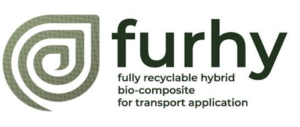REPOXYBLE cooperates with other EU projects, in particular:
FOREST
Advanced lightweight materials FOR Energy-efficient STructures

The FOREST project contributes to the decarbonisation of the transport sector by developing and implementing innovative bio-based polymers & additives and recycled carbon fibres. The goal combines three key drivers: Reduce, Recovery, and Reshape.
Reduce: on one hand, reduce vehicles’ structural weight by providing light components made of carbon fibre reinforced plastic. In this way, less fuel and energy consumption will be necessary to cover the same distance. On the other hand, develop new chemistries based on high-biobased content for polymers and additives, reducing the fossil sources’ dependency.
Recovery: implement efficient methods to recover 100% of carbon fibre waste to develop high-quality semi-finished materials for valuable transport applications.
Reshape: research the influence of the multifunctional properties on the biocomposite (mechanical, fire-retardant, and EMI-shielding), combining the biobased, recycled, and multifunctionality material nature to obtain sustainable solutions for the bus, aeronautic, and automotive sectors.
r-LightBioCom
New bio-based and sustainable raw materials enabling circular value chains of high performance lightweight biocomposites

r-LightBioCom develops new sustainable, cost-effective and energy-efficient lightweight high-performance composites with inherent recycling properties, in combination with novel efficient processing and recycling techniques; their environmental impact is reduced during their production, operation and after reaching their final lifetime, while offering improved mechanical properties, weight reduction and new functionalities.
New lightweight High-Performance Composite (HPC) materials and efficient sustainable processing technologies will have an enormous environmental and performance benefit in all sectors; however, current sustainable HPC application is limited to large sectors due to their long processing times, high prices and low recyclability.
To overcome these limitations, r-LightBioCom propose a paradigm shift in the way HPC are manufactured and recycled, unlocking sustainable-by-design production of lightweight HPC. The project will enable new circular value chains, reducing the HPC waste generation and the use of non-sustainable fossil resources, as well as developing efficient processing techniques combined with recycling technologies.
SUSPENS
Sustainable structural sandwiches and hollow composites parts for automotive, boat and aerospace markets

SUSPENS addresses the challenge of reducing the environmental footprint of sandwich and hollow composite structures for the automotive, leisure boat and aerospace industries.
The project consortium will develop over 95% bio-sourced epoxy and polyesters resins, with new formulations leading to high performance, combined with sustainable and recyclable fibres to an industry standard.
Recycling solutions for such structures will also be developed in the project to cover the entire life cycle of the target applications.
The general project approach will be demonstrated through the manufacturing of three representative parts such as a car battery pack, a leisure boat deck and hull and an aircraft winglet.
FURHY
FUlly Recyclable HYbrid bio-composite for transport applications

FURHY develops new, bio-based, smart and fully recyclable composite material, obtained by fast and low energy consumption out-of-autoclave process, to foster a more sustainable mobility in our cities.
FURHY matrix will be made by a new bio-based epoxy resin formulation filled by expanded graphite, that will have a multiple role in the enhancement of both material and manufacturing process, providing smart-functions. A hybrid composite is developed using hemp and recycled carbon fibres, thus maximizing the environmental benefits with a life-cycle perspective. The hybridization allows to exploit the advantages offered by both fibres, minimizing the relevant drawbacks.

